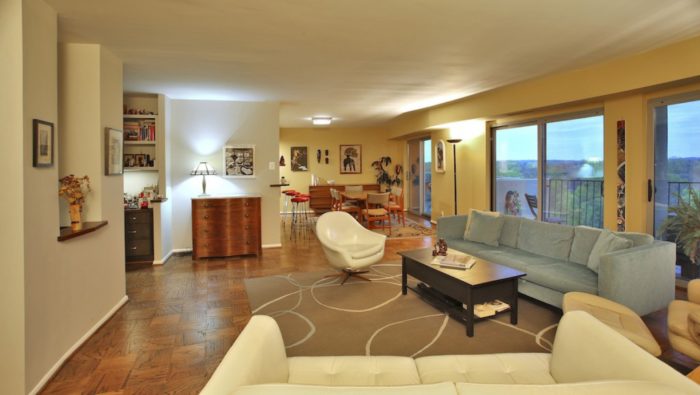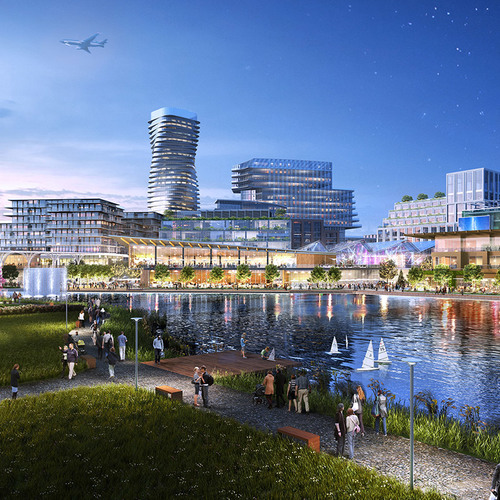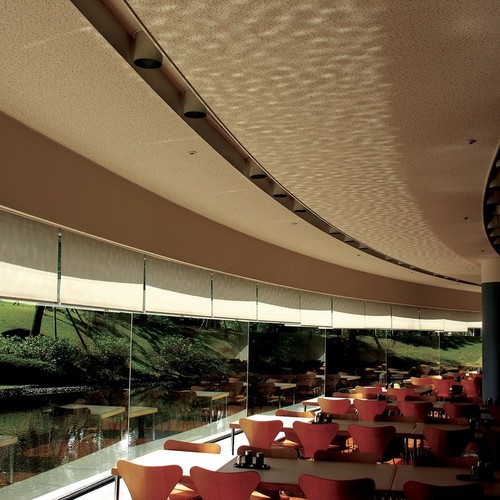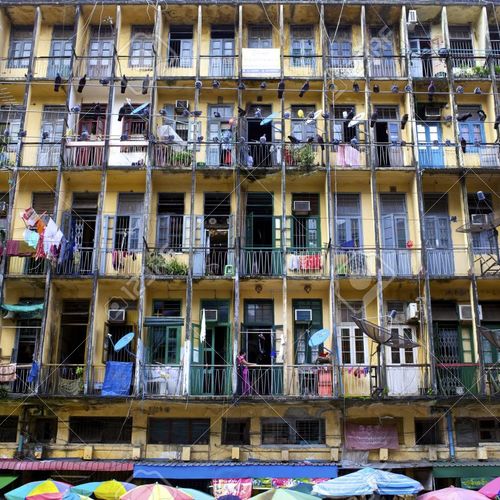
Image Credit: All photos: Ken Wyner
Image Credit: All photos: Ken Wyner Before it was renovated, the condo was a bleak, worn-out wreck. The same view after the renovation shows that partitions have been moved and shaped to allow light from the floor-to-ceiling glass doors (not shown in the photo) to reach the back wall of the condo unit. The floor plan of the existing condo before renovation. Partitions and doorways were reshaped and finessed. The redesign focused on defining functional spaces for work, hobbies, and overnight guests. It brought order and reason to bear upon unreasonably bad feng shui. The partition doesn't go all the way to the ceiling, allowing light and air to flow into this inner hallway. The new kitchen is conveniently open to the front entry as well as the main living area (out of frame to the right). Open to dining and living room, the kitchen is illuminated by natural daylight from floor-to-ceiling windows (out of frame to the left). The walnut countertop was made from "urban harvest" lumber by Marcus Sims. A striking range hood made from scrapyard stainless steel anchors the room. Patrick Sells of Salvaging Creativity fabricated the range hood. The vanity cabinet is capped with locally fabricated concrete. Daylight from floor-to-ceiling windows invigorates the rich wall color of the master bedroom.
The purpose of sustainable design and green building is to achieve sustainable living. To do this, we attempt to make best possible use of the assets at hand. That could mean designing and building from scratch. It could also mean taking an existing dwelling and nudging it in the direction of sustainability.
It’s an imperfect process and takes time. It’s only natural that we look for shortcuts to living green. Here’s one: downsize and move into a condo.
Do what our clients did. When the time was right, they sold their single-family detached house. They kissed their lovable, drafty old Victorian goodbye. With the kids fledged and their careers on cruise control, they didn’t need it anymore. So they bought a dowdy condo on the upper floors of Parkside Plaza in Silver Spring, Maryland, and transformed it into their own cool, colorful, light-filled living space.
What’s sustainable or green about living in a high-rise, you say? Read on.
A lazy man’s way to living green
Depending on the year it was built, a condominium building may be burdened by outdated or inefficient systems. And yet, these buildings start out with two big gold stars on the list of sustainable design features: energy efficiency and sustainable land use.
Energy efficiency. A free-standing house is exposed to the elements on all sides plus the roof. The typical apartment shares three of its walls (plus floor and ceiling) with other units or common areas. So, right there without lifting a finger you’ve just become 80% more energy efficient because only one wall has to face the elements.
Sustainable land use. The other big painless step toward sustainability has to do with land conservation. A single-family house occupies at least 5,000 or 6,000 square feet of land. In a multifamily building like Parkside Plaza, 250 families occupy about four acres. That’s an average of less than 700 square feet per family.
So, if you were a complete deadbeat and did nothing else to ease your footprint on our tender Earth, you’d be ahead of the game with this one simple move. And why stop when you’ve started out so far ahead?
That brings us to our green remodeling story. Our clients found a bleak, worn-out wreck of a place and loved it into a work of lifestyle art.
To see what they walked into, check out Image #2, below. Where others may have flinched and fled, they saw potential. Image #3 shows the same view after renovation: partition walls have moved and been shaped to allow light from the floor-to-ceiling glass doors to reach the back wall of the condo unit.
One plus one makes one big one
When the Parkside Plaza building converted to condominiums around 1988, several pairs of one-bedroom apartments on the top floors were combined to create spacious luxury units.
Except …
The apartments had been stuck simply (and oddly) together, the possibilities of the combined spaces left unexplored. As a result, the space lacked definition or any unifying themes. Closets and storage spaces were haphazard. Nothing related to anything else.
And …
The original single-glazed windows and doors leaked, rattled, and whistled in the wind. The heating/cooling units were choked with crud and they leaked, ruining the floors.
And, finally …
The kitchen. It was one of those kitchens made so long before we learned how to “do” kitchens that it doesn’t seem fair to criticize. Boxed off from the main living area, it cried out to be set free of confining partitions. It is enough to say it was intolerable to our empty-nesters.
Accentuate the positive
Was there anything good about the place? Yes! It was luxuriously spacious. Truly splendid, however, were the floor-to-ceiling sliding glass doors framing a wall of sky beyond twin over-sized balconies. This! This was worth the work. And work there was.
Even with so much wrong, the renovation relied more on the scalpel than the wrecking ball. As shown in the detail below (see Image #5), partitions and doorways were reshaped and finessed.
The redesign would focus on defining functional spaces for work, hobbies, and overnight guests. It would bring order and reason to bear upon unreasonably bad feng shui.
Making sense of space: interior realignment
Transitions were clarified. Storage was optimized. What had been a dark and creepy passageway to the second bedroom was illuminated by interior windows and divided-light bedroom doors.
The kitchen was fully integrated into the adjacent living areas (see Image #8, below).
Repurposing found materials
Materials were selected with sustainability in mind. These included wood counters and shelves crafted from urban harvest walnut and cherry (see Image #9).
Patrick Sells of Salvaging Creativity, York, Pennsylvania, fabricated the range hood with stainless steel from a local scrapyard (see Image #10). It was a thrill to be able to work with these artists to incorporate reused and recycled materials in the project.
To ensure healthful indoor air quality, cabinets were made with zero-formaldehyde materials and finished with no-VOC coatings.
One of the huge successes in this green living project is the use of color (see Image #12, below, showing the master bedroom). The owner, an artist in her own right, created the palette.
Living sustainably is living well
Sustainable design elements included in this green remodeling project feature the usual cast of characters: LED lighting, Water Sense fixtures, Energy Star appliances, and energy-saving doors and windows insulated with low-e, argon-filled double glazing.
But the most sustainable aspect of this green living project is downsizing. It proves that it is possible to do much more with much less than we think we may need.
Alan Abrams is a Certified Passive House Consultant, a Certified Passive House Builder, a
Certified Green Professional (NAHB), and a Certified Professional Building Designer (American Institute of Building Designers). He is also the owner of Abrams Design Build in Takoma Park, Maryland.
Weekly Newsletter
Get building science and energy efficiency advice, plus special offers, in your inbox.














12 Comments
Very Nice
Very nice build.
This is the type of collaboration I have done and have a passion for. Personally to be honest I would have to rewrite this blog and post it as a fine homebuilding article removing the green angle.
Green is building cities? No. Green is less population. Green is zero utility energy use. Green is living in the bush in Africa. Green is designing a safe thorium based nuclear energy source. Green is not a condo that needs high tax city resources, thousands of watershed acres outside the city, steel mills, power plants, etc. You have a great set of blinders on if you think a condo is green.
As a build, great.
Condo Hell
Living in a condo means putting up with all manner of busy-bodies and restrictions on everything from flying the flag to grilling a steak to what kind of car one chooses to drive.
Then there is putting up with everything from unwanted music to tobacco smoke to barking dogs from one's neighbors.
Then there are the endless fees, assessments, and HOA meetings.
Want to line dry? Install PV? Mount a dish antenna? Fuhgedaboutit!
Green? Perhaps. Acceptable to me? not.
Not ready yet
A condo is great if that is your lifestyle. As I have told my wife, I will be ready when I have one foot in the grave. I enjoy too much being outside in the yard and in my workshop.
And of course, putting up with your neighbors second hand tobacco smoke.
Things change
Alan,
Nice post. Increasing density is a positive trend, and lifestyles change.
AJ,
Green could also be an effort. Progress takes steps, and steps take time. We can't all order the bear meat with Demi glaze. (If you recall the post)
Perhaps time is short. That just throws thingsI to your "adaptation" court.
Bear meat with demi-glace...
Albert,
That's going back a ways - good memory.
"Sustainable living"?
Interesting article...
But it would be nice if the use of the word "sustainable" could be abandoned.
While it is probably true that high density living is a more efficient way to organize ourselves, it does not necessarily follow that this configuration is therefore "sustainable".
Response to AJ
Cities are just about the ultimate green, unless you want to live the ultimate hunter gatherer lifestyle in the African bush. Personally I like my iPhone, and queen size bed too much to live the African bush lifestyle.
As for the tax resources a Condo needs, in many ways those are lower than suburban living require. I suggest you visit http://www.strongtowns.org and read up on their message about the tax consequences of nonurban living.
Andres Duany, points out that a compact city preserves the surrounding environment, even though the individual buildings may take more intensive infrastructure to build and support.
Condo and Apartment living has it's pluses and minues, it is a lifestyle choice. It is a lifestyle choice that is decidedly "greener" than current suburban sprawl. It is also a lifestyle choice that does not need further belittlement, as the current belittlement of that lifestyle has helped increase suburban sprawl.
reread my post Don
I am not advocating suburbs or sprawl.
Nothing green about current condos or cities or suburbs.
We may not want to live in the bush but that still doesn't mean this condo blog is more than a good fine homebuilding post.
Too many people are converting too much of this planet into too much pollution.
Your condo has not stopped or started the reduction of ocean pollution for example.
Small step toward green? Not for me. Green bloviating absolutely.
Bear meat with demi-glace...
Lol... On tonight's barbecue menu...
A walnut demi-glace.
Bears not sustainably harvested.... But tasty none the less.
Green enough.
The exurban, go-it-alone tradition of the green building movement is showing its underskirts in the comments here. No forest was clearcut, no new roads and driveways built, no concrete poured (other than the vanity sink) to give this home a brand new lease of life.
points well taken
in the scheme of things, I agree that this project may be on the paler side of green. That the owners greatly reduced their own footprint does not consider that the home they left--a rambling wood frame house built in 1896--is now occupied by a new family. In other words, one's individual decision of this sort does not in itself reduce the greater community's overall footprint.
On the other hand, one can evaluate this project in terms of specific improvements to the space--two in particular that reduce energy and water use:
*replacing 283 sf of 1960's horribly leaky, single glazed, aluminum clad windows and patio doors with low-e, thermally broken units--more doubling the R-value of more than half of the exposed surface area of the apartment
*replacing all water-using fixtures and appliances with more efficient products.
(it would be informative to compare energy profiles before and after, but the building is net metered)
As to the comments on condo living--I live in the same building. It's true that there is a rule prohibiting drying your clothes on the balcony, which I am striving to have changed (and which I also flaunt from time to time)--not to mention other annoyances--but the tradeoff of practical conveniences and a special type of community is worth it to me.
There's another dimension to this story, though. The owners (like myself) are retirement age and well aware of the prospects of limitations to mobility as we age. The renovation widened doorways and straightened out hallways, to facilitate wheelchair access should the need arise. The point being, that moving to an accessible home before the need arises might preclude the need to go into an assisted environment--with the intense footprint that such facilities entail.
Readers who are interested in this topic might enjoy another perspective on this: http://newoldage.blogs.nytimes.com/2013/09/10/getting-while-the-getting-is-good/?ref=health&_r=1&
not responsible?
Really, is there any more efficient use of resources than re-use?
Log in or create an account to post a comment.
Sign up Log in